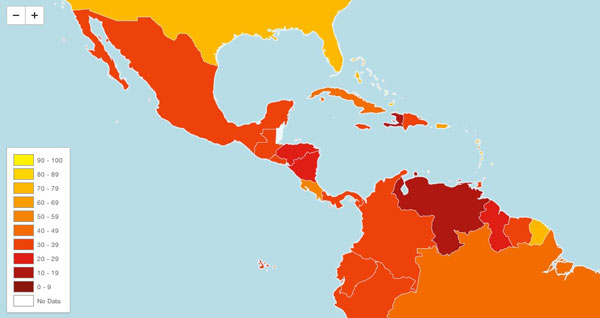
Costa Rica ranks 48th in Transparency International’s 2012 Corruption Perceptions Index (CPI) which measures perceived public sector corruption in 176 countries. Costa Rica’s score in the 2012 survey is 54 on a scale of 0 (perceived to be highly corrupt) to 100 (perceived to be very clean).
The 2012 CPI was calculated using an improved methodology which does not allow to compare the data with previous surveys.
The countries with the lowest perceived corruption in 2012 are Denmark, Finland, New Zealand, Sweden and Singapore. Meanwhile, Myanmar, Sudan, Afghanistan, North Korea and Somalia are found at the bottom of the ranking.
The CPI scores and ranks countries/territories based on how corrupt a country’s public sector is perceived to be. It is a composite index, a combination of surveys and assessments of corruption, collected by a variety of reputable institutions.
This year’s CPI scores were calculated with a new methodology, which means that the 2012 results are in no way comparable with those from 2011 or earlier years. However, the new methodology will make it possible to compare CPI results from different years from 2012 onwards.
On the Control of Corruptons (2010) Costa Rica has a 73% percentage rank and a score of 0.667635213.
The Control of corruption reflects perceptions of the extent to which public power is exercised for private gain. This includes both petty and grand forms of corruption, as well as “capture” of the state by elites and private interests. The Control of corruption is one of the six dimensions of the Worldwide Governance Indicators.
Point estimates range from about -2.5 to 2.5. Higher values correspond to better governance outcomes.
In measuring transperancy, Transperancy International ranks Costa Rica 44th of 71, with a score of 77 and a value of 177.2 in the Financial Secrecy Index (2011).
The Financial Secrecy Index identifies and ranks jurisdictions according to their level of financial secrecy and their share of the global market for offshore financial services. The index focuses on secrecy jurisdictions that have laws and systems which provide legal and financial secrecy to others elsewhere.
According to the World Bank data, Costa Rica has a Population (2010) of 4.7 million, a GDP (2010) of US$35.83 billion, an Infant Mortality Rate (per 1.000 live births – 2010) of 8.7 , a Life Expectancy (2009) of 79.07 years and a Literacy Rate (2009) of 96.1%.
 |
| |
More Regional News
Drought Will Hit Communities with Water Shortages
Starting now, several communities in the Canton of Nicoya will have to have patience as water rationing will be the order of the day since this past rainy season left a 25% shortage of water, according to Water and Sewer (AyA—Acueductos y Alcantarillados).
New Law Could Bring Salary Changes to Wait Staff Served
A decision by the constitutional court in San Jose, in a 6-1 vote, made to streamline income and collect taxes on it, could mean the loss of millions of colones for serving and wait-staff across the country.
Increase in Crime with Return of Tourists
During the first 15 days of November, the beginning of tourist season, the tourist police reported an increase in the number of crimes against property. At the same time, Jeison Vargas, tourist police chief in Guiones, assured that this is what the tourist police are here for and that they are visiting the area businesses every day.
Thieves Steal Boat Engine in Garza
On the morning of Monday, November 19th, Juan Rafael Hernandez Salguera (known as Juan Mora) of Garza received a phone call that his boat was missing. The anchor had been cut.
Archeologists Didn’t Find Indian Remains in Front of Colonial Church
Nicoyans have expressed divided opinions over the construction of a new plaza in front of the Colonial Church. One of the concerns manifested by some is about the existence of indigenous remains en the area where they are moving earth.
Water May Cause Illnesses in Nosara Schoolchildren
On November16th, Serapio López School filed a complaint with the Ministry of Health after several children had health problems, apparently caused by water consumption in their facilities. |
 |
|
|

